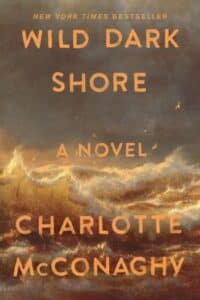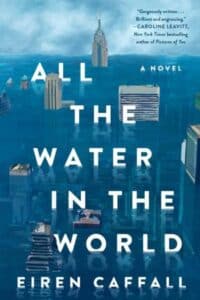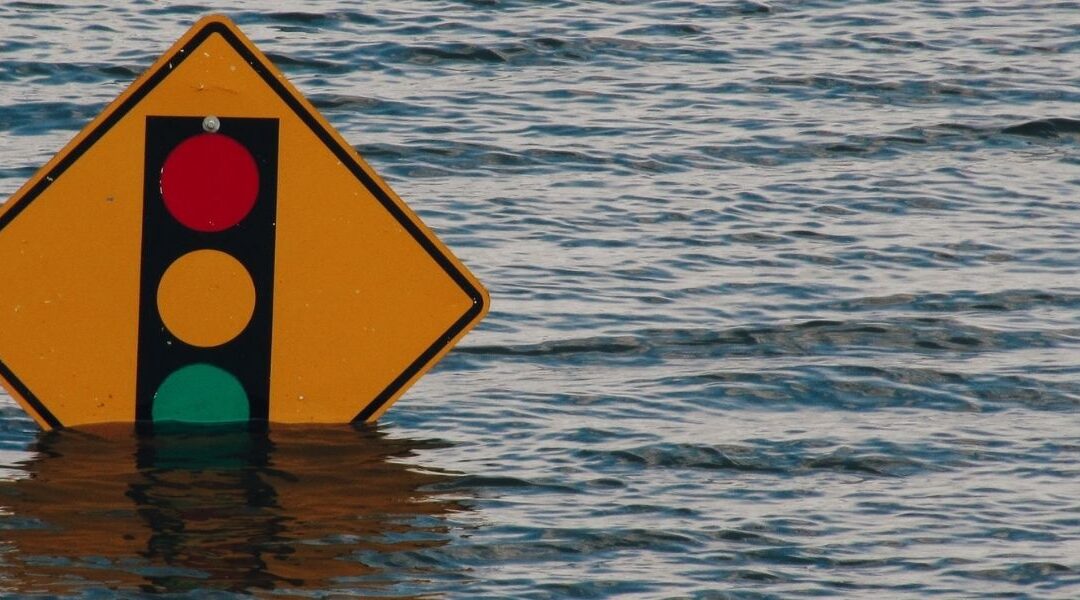Eco-fiction Book Reviews by Ross Thrasher
“The water is only doing what it must. It is old and it is smart, and it has been changing forever, and we can no more fight it than we can fight the sky.” (From All the Water in the World)
Two excellent new novels encompass similar motifs: the impact of water as the climate warms, the limits of human adaptability, and our duty to the future in preserving what we can of our past.
Wild Dark Shore by Charlotte McConaghy. Flatiron Books, 2025.
A woman named Rowan washes ashore, unconscious, at Shearwater Island, a remote sliver of the earth’s crust halfway between Australia and Antarctica. Shearwater, a breeding ground for penguins, seals and migrating birds, is a fictional analogue of the real-life Macquarie Island administered by Tasmania.
(Macquarie has had a colourful history. In the 19th century it was a base for whalers, and the fur seal population was slaughtered nearly to extinction for their skins. Later, invasive species like rabbits and rats overran the island.)
 The novel reveals that for some years Shearwater has hosted a research station, but the island is now being submerged by rising sea levels, due to the rapid melting of the Antarctic glaciers. The scientists have just been evacuated, leaving only a widowed caretaker, Dominic, and his three children to pack up the essentials prior to departure.
The novel reveals that for some years Shearwater has hosted a research station, but the island is now being submerged by rising sea levels, due to the rapid melting of the Antarctic glaciers. The scientists have just been evacuated, leaving only a widowed caretaker, Dominic, and his three children to pack up the essentials prior to departure.
Rowan is rescued by the family and nursed back to health. She explains that she came to find her husband Hank, who had sent her distress messages, but she was shipwrecked offshore. Hank was in charge of a seed vault on the island, a repository for thousands of worldwide plant species to save them from climate change.
(This is another nod to the real world. A global seed vault as a secure backup facility for the world’s crop diversity has actually been established on the Norwegian island of Spitzbergen in the remote Arctic.)
Dominic claims that Hank left with the other scientists, but Rowan will uncover troubling evidence suggesting otherwise. In the meantime she bonds with the family. Dominic is standoffish, but the children are keen to engage with her. Raff, 18, has recorded whale sounds and mimics them on his violin. The daughter Fen, 17, swims with the seals and closely monitors all the breeding activities of the wildlife on the island. Precocious nine-year-old Orly displays an oceanic knowledge of and love for the natural world. Perhaps they see Rowan as a surrogate mother. And after a prickly beginning, Rowan and the taciturn Dominic develop a strong attraction for each other.
Life on Shearwater seems idyllic, but conditions are harsh — wild storms, cold weather, then a power and radio outage. The residents all carry burdens of grief, anger and guilt. Dominic’s long-dead wife still speaks to him. Rowan is mourning the recent destruction of her dream home in Australia during a wildfire. The effects of isolation and the loss of their mother are wearing on the children in various ways.
A ship is due soon to retrieve these last islanders, along with the contents of the seed vault which they are rushing to pack up per Hank’s previous instructions. This Herculean task is interrupted by the need to relaunch a beached whale and her calf into the sea. The wind howls and the waters rise. Then a shocking discovery is made.
In short, Wild Dark Shore is a combination Swiss Family Robinson-type adventure tale and eco-thriller. The author deftly unfurls her story by alternating the voices of the various characters in a tidal flow of events and memories. McConaghy in this novel has nested a planetary ecological theme within a fraught family saga. Well done!
Charlotte McConaghy is an Australian writer whose previous novels, Migrations and Once There Were Wolves, also feature environmental elements.
All the Water in the World, by Eiren Caffall. St. Martins Press, 2025.
Sometime in the future, New York City has been inundated by a series of “hypercanes”: super-hurricanes and tornadoes packing historic wallops of wind and rain. The city has been completely shut down and largely abandoned. A cluster of survivors is huddling on the roof of the American Museum of Natural History. They have built primitive shelters, calling this makeshift community Amen. Among the group are a curator, Allan, his teenaged daughters Nonie and Bix, and his colleague Keller.
 The narrative loops back and forth in time, describing their previous lives in the city, how they retreated to the rooftop after earlier superstorms, barricading the building against the Lost — other desperate refugees. A mosquito-borne plague has carried away many who survived the floods. Museum staff have packed up as many artifacts as possible and relocated them to safe storage offsite. This information is documented in a Logbook, to which Nonie adds marginal notes.
The narrative loops back and forth in time, describing their previous lives in the city, how they retreated to the rooftop after earlier superstorms, barricading the building against the Lost — other desperate refugees. A mosquito-borne plague has carried away many who survived the floods. Museum staff have packed up as many artifacts as possible and relocated them to safe storage offsite. This information is documented in a Logbook, to which Nonie adds marginal notes.
When another hypercane hits, the winds destroy Amen and the waters rise so high that the familial foursome has to evacuate in a canoe liberated from a museum exhibit. In an incredible escape, they paddle between the treetops of Central Park and around the flooded high-rise buildings of the city to the tidal mouth of the Hudson River. Their destination is a farm upstate on higher ground, owned by friends of Allan’s.
All the Water in the World is a post-apocalyptic narrative whose grimness is leavened by flashbacks to happier times, when the girls were able to use the Museum and its library as their classroom. Urban systems had failed, the electricity grid was off and the city had emptied out. As the water receded between storms, the residents of Amen had been able to get out and forage for food and medicine — breaking into shuttered shops, bow-hunting deer in the park. They grew whatever they could in a rooftop garden.
Nonie the narrator has reveries about The World As It Was: the loved ones in her life, many of whom she has lost, including her mother to an incurable illness. Her sister Bix has developed a phobia about water. In the latter half of the book, their odyssey by canoe along the swollen Hudson is harrowing. But led first by their father and Keller, and later by strangers who become friends along the way, they finally reach the farm and safety, clinging to a shred of hope for the future.
Water is never far from their thoughts. Dreaming of an alternate reality on an ocean-going vessel, Nonie recalls a line from Moby Dick: “in landlessness alone resides the highest truth, shoreless, indefinite as God”. This eloquent novel, like Melville’s classic, reminds us that while water is life, it has the power to drown our greedy, careless civilization.
– 30 –
Read more book reviews in GTEC’s Communications & Media section here.
 Ross Thrasher
Ross Thrasher
Ross has enjoyed a 30-year career as a librarian at post-secondary institutions in Canada, the U.C. and the South Pacific. Most recently he served for eight years as Library Director at Mount Royal College in Calgary, leading the library’s transition to university status. In retirement Ross maintains an active interest in literature, travel and the performing arts.

